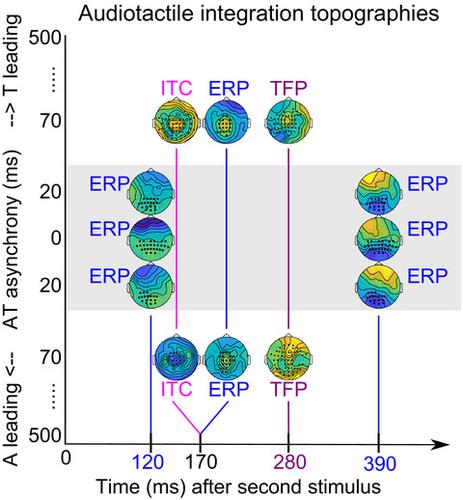当前位置:
X-MOL 学术
›
Eur. J. Neurosci.
›
论文详情
Our official English website, www.x-mol.net, welcomes your
feedback! (Note: you will need to create a separate account there.)
The neural mechanisms of audiotactile binding depend on asynchrony.
European Journal of Neuroscience ( IF 2.7 ) Pub Date : 2020-07-29 , DOI: 10.1111/ejn.14928 Johanna M Zumer 1, 2, 3, 4 , Thomas P White 1, 2 , Uta Noppeney 1, 2, 3, 5
European Journal of Neuroscience ( IF 2.7 ) Pub Date : 2020-07-29 , DOI: 10.1111/ejn.14928 Johanna M Zumer 1, 2, 3, 4 , Thomas P White 1, 2 , Uta Noppeney 1, 2, 3, 5
Affiliation

|
Asynchrony is a critical cue informing the brain whether sensory signals are caused by a common source and should be integrated or segregated. This psychophysics–electroencephalography (EEG) study investigated the influence of asynchrony on how the brain binds audiotactile (AT) signals to enable faster responses in a redundant target paradigm. Human participants actively responded (psychophysics) or passively attended (EEG) to noise bursts, “taps‐to‐the‐face” and their AT combinations at seven AT asynchronies: 0, ±20, ±70 and ±500 ms. Behaviourally, observers were faster at detecting AT than unisensory stimuli within a temporal integration window: the redundant target effect was maximal for synchronous stimuli and declined within a ≤70 ms AT asynchrony. EEG revealed a cascade of AT interactions that relied on different neural mechanisms depending on AT asynchrony. At small (≤20 ms) asynchronies, AT interactions arose for evoked response potentials (ERPs) at 110 ms and ~400 ms post‐stimulus. Selectively at ±70 ms asynchronies, AT interactions were observed for the P200 ERP, theta‐band inter‐trial coherence (ITC) and power at ~200 ms post‐stimulus. In conclusion, AT binding was mediated by distinct neural mechanisms depending on the asynchrony of the AT signals. Early AT interactions in ERPs and theta‐band ITC and power were critical for the behavioural response facilitation within a ≤±70 ms temporal integration window.
中文翻译:

听觉结合的神经机制取决于异步性。
异步是告知大脑感觉信号是否由共同来源引起的关键信号,应该被整合或隔离。这项心理物理学脑电图(EEG)研究调查了异步对大脑如何绑定听觉(AT)信号以实现冗余目标范例中更快响应的影响。人类参与者在七个AT异步时间:0,±20,±70和±500 ms上对噪声爆发,“轻拍”及其AT组合做出积极反应(心理物理学)或被动参加(EEG)。行为上,观察者检测AT的速度比时间积分窗口中的单感觉刺激更快:冗余目标效应对于同步刺激最大,并在≤70 ms AT异步时间内下降。脑电图揭示了一系列取决于AT异步性的依赖于不同神经机制的AT相互作用。在较小的异步时间(≤20 ms)下,刺激后110 ms和〜400 ms时,AT相互作用产生了诱发反应电位(ERP)。选择性地在±70 ms的异步条件下,在刺激后约200 ms的时间内观察到了P200 ERP的AT交互作用,θ波段间相干性(ITC)和功率。总之,取决于AT信号的异步性,AT结合是由不同的神经机制介导的。ERP中早期的AT交互以及θ带ITC和功率对于在≤±70 ms的时间积分窗口内促进行为响应至关重要。在刺激后约200毫秒,观察到了P200 ERP,θ带间相干性(ITC)和功率的AT交互作用。总之,取决于AT信号的异步性,AT结合是由不同的神经机制介导的。ERP中早期的AT交互以及θ带ITC和功率对于在≤±70 ms的时间积分窗口内促进行为响应至关重要。在刺激后约200毫秒,观察到了P200 ERP,θ带间相干性(ITC)和功率的AT交互作用。总之,取决于AT信号的异步性,AT结合是由不同的神经机制介导的。ERP中早期的AT交互以及θ带ITC和功率对于在≤±70 ms的时间积分窗口内促进行为响应至关重要。
更新日期:2020-07-29
中文翻译:

听觉结合的神经机制取决于异步性。
异步是告知大脑感觉信号是否由共同来源引起的关键信号,应该被整合或隔离。这项心理物理学脑电图(EEG)研究调查了异步对大脑如何绑定听觉(AT)信号以实现冗余目标范例中更快响应的影响。人类参与者在七个AT异步时间:0,±20,±70和±500 ms上对噪声爆发,“轻拍”及其AT组合做出积极反应(心理物理学)或被动参加(EEG)。行为上,观察者检测AT的速度比时间积分窗口中的单感觉刺激更快:冗余目标效应对于同步刺激最大,并在≤70 ms AT异步时间内下降。脑电图揭示了一系列取决于AT异步性的依赖于不同神经机制的AT相互作用。在较小的异步时间(≤20 ms)下,刺激后110 ms和〜400 ms时,AT相互作用产生了诱发反应电位(ERP)。选择性地在±70 ms的异步条件下,在刺激后约200 ms的时间内观察到了P200 ERP的AT交互作用,θ波段间相干性(ITC)和功率。总之,取决于AT信号的异步性,AT结合是由不同的神经机制介导的。ERP中早期的AT交互以及θ带ITC和功率对于在≤±70 ms的时间积分窗口内促进行为响应至关重要。在刺激后约200毫秒,观察到了P200 ERP,θ带间相干性(ITC)和功率的AT交互作用。总之,取决于AT信号的异步性,AT结合是由不同的神经机制介导的。ERP中早期的AT交互以及θ带ITC和功率对于在≤±70 ms的时间积分窗口内促进行为响应至关重要。在刺激后约200毫秒,观察到了P200 ERP,θ带间相干性(ITC)和功率的AT交互作用。总之,取决于AT信号的异步性,AT结合是由不同的神经机制介导的。ERP中早期的AT交互以及θ带ITC和功率对于在≤±70 ms的时间积分窗口内促进行为响应至关重要。











































 京公网安备 11010802027423号
京公网安备 11010802027423号